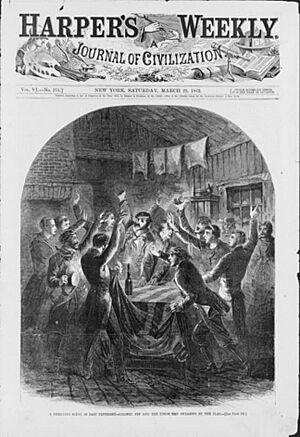East Tennessee bridge burnings facts for kids
The East Tennessee bridge burnings were a series of secret attacks during the American Civil War in 1861. People who supported the Union (the North) lived in Confederate-controlled East Tennessee. They worked together to destroy important railroad bridges.
A minister named William B. Carter planned these attacks. President Abraham Lincoln approved the idea. The plan was to destroy nine key railroad bridges. After the bridges were gone, Union soldiers from Kentucky would invade the area. The attackers managed to destroy five bridges. However, the Union Army did not invade right away. They waited almost two years, until 1863.
The destroyed bridges were quickly rebuilt. So, the attacks did not have a big military impact. But the attacks changed how Confederate leaders saw Union supporters in East Tennessee. Some areas were put under military rule. Many Union supporters were arrested and put in jail. Several people thought to be bridge burners were found guilty. They faced serious consequences. This made President Lincoln feel more pressure. People wanted him to send Union troops to East Tennessee.
A newspaper publisher named William G. "Parson" Brownlow supported the Union. He used the arrests and punishments as propaganda. He wrote about them in his 1862 book. It was called Sketches of the Rise, Progress and Decline of Secession.
What Happened After the Bridge Burnings?

William Carter had promised to keep the names of the bridge burners a secret. He never told anyone, even after the war ended. Because of this, many people involved are still unknown today. In 1871, some names became public. This happened when a leader named Alfred Cate asked the government for payment for their actions.
Later, in the 1890s, Oliver Perry Temple found more names. He wrote to people who were known to be involved. He was collecting information for his book. It was called East Tennessee and the Civil War.
Stories and Books About the Bridge Burnings
Many stories have been written about the bridge burnings. Oliver Temple's book gave a lot of details. In 1862, a Confederate named Radford Gatlin wrote a story. He praised James Keeling's actions at the Strawberry Plains bridge. Gatlin had been forced out of his hometown, Gatlinburg, which supported the Union.
Union supporters Thomas William Humes and William Rule were in Knoxville during the burnings. They wrote short accounts in their books in the late 1880s. William E. Barton wrote a fictional story about the conspiracy. This was in the late 1890s. More recently, Cameron Judd wrote a historical novel in 1995. It was called The Bridge Burners. In 1996, Donahue Bible, a historian, wrote a book. It was about the Lick Creek bridge burners. The book was titled Broken Vessels: The Story of the Hanging of the Pottertown Bridge Burners.
Honoring the Bridge Burners
In 2002, a special stone monument was put up near Mosheim. It honors five Pottertown bridge burners. These men faced severe punishment from Confederate leaders. They had helped destroy the Lick Creek bridge. The monument is near Harmon Cemetery. Two of the bridge burners, Jacob and Henry Harmon, are buried there. A nearby road has been named "Bridge Burners Boulevard." It connects Pottertown Road with U.S. Route 11.


